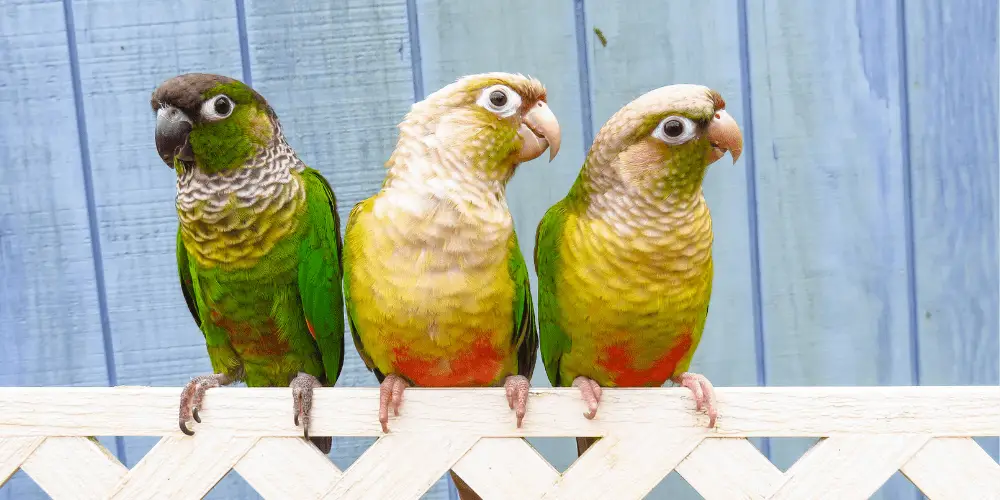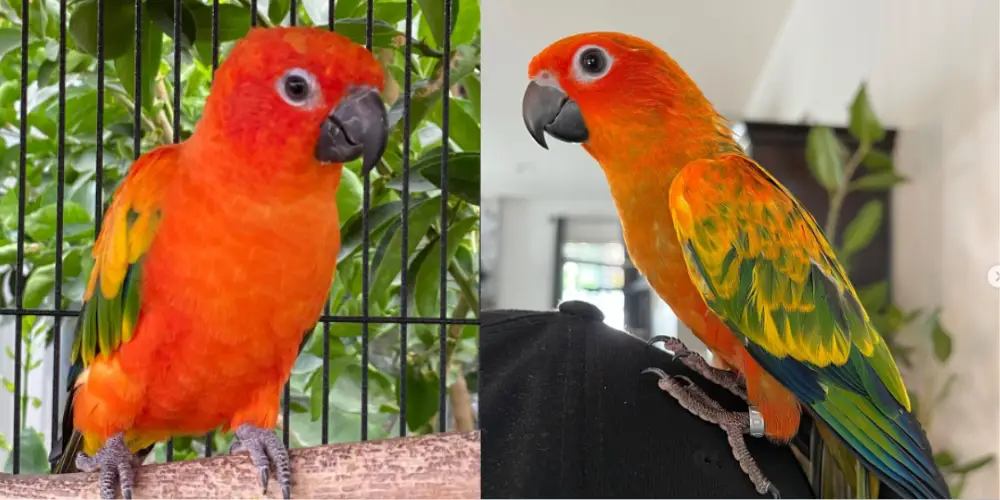Green Cheek Conures are a popular and plentiful bird breed, and there are several good reasons why this is true. One of those reasons is the variety of colors the bird can have, which leads us to the topic at hand, the Pineapple Green Cheek Conure.
The Pineapple Green Cheek Conure is a more colorful (yet rare) variety of the Green Cheek, resulting from the mutation of Cinnamon and Yellow-sided Conure. They stand about ten inches tall and originally come from South America.
There are all kinds of fun info that we’ll be talking about concerning this beautifully mutated variety of the Green Cheek. Keep Reading!
Pineapple Green Cheek Conure Temperament

The Pineapple Green Cheek Conure is a trainable, well-behaved bird, which is why so many people find it to be a great pet. They’re friendly, affectionate, curious, and engaging with their owners. Most of these birds enjoy cuddling with their owners whenever they can.
As all birds do, they can get into a mood sometimes, being irritated at whatever the case may be, but is an overall friendly, happy-natured birds.
Feeling, Nipping, and Biting
The following is true for all parrot subspecies, but some birds are less intimidating than others- There is a big difference between a feel, a nip, and a bite, and all birds at some point will display all three at certain times.
This can be an incredibly intimidating trait for the novice owner, as nobody wants to get bit, right?
New owners often throw in the towel because it seems their bird wants to bite them all the time rather than hang out and be affectionate.
There is often a misunderstanding of intentions with birds. This is where some education on the matter is important, not to ruin what could be a rewarding owner and pet experience that can last for a long time.
Conures Feeling Things Out
Parrots can be taught to give a handshake, where it reaches out their claw to shake your finger (or something to that effect). But that’s a trained action rather than a natural action. That’s not how they introduce themselves, nor how they naturally say “hello”.
Parrots, including the Pineapple Green Cheek Conure, come at you with their beak instead- at least, that’s what it appears at first. They’re truly trying to get close enough to feel you (or an object it’s interested in) with their tongue.
That’s how they say hello, gain trust, and become familiar and comfortable with you. This is one of the reasons why the Green Cheeked Conure is a good starting point for Parrot ownership.
They’re the smallest of their kind, and a mistake of intentions won’t hurt as bad as a Blue and Gold McCaw, which looks like it can remove people’s ability to count to ten on all ten fingers if someone mistakes mad for affection for some reason.
Conures Being Nippy
I know this isn’t big news, but birds, including the Pineapple Green Cheeked Conure, do not have hands. They only have one way to bring something closer to it or to bring themselves closer to something (or someone) else- with its beak.
The beak is its primary tool to get around where its clipped wings and claws won’t do the trick. Sometimes it’ll get nippy just trying to say, “get over here!” Getting your attention by nipping is a choice they’ll use rather than squawking at times.
However, this isn’t always the case. Sometimes they’ll nip out of being nervous, apprehensive, or as a sign to say “back off.”
Perhaps they’re new to a space or a family and have become nervous about it. Or maybe it isn’t feeling 100% at the time or is telling you it’s hungry?
At worst, the nip is a plea to be left alone because it doesn’t want to have to bite you.
When Conures Bite
There is no such thing as a carnivorous parrot short of naturally eating an insect or two. That said, they bite for different reasons inherent to the species.
Biting can occur when a parrot becomes frustrated and lashes out at an owner or an object. When they do it to an object, it can be humorous to watch. It can be a more intimidating and painful experience when it’s toward an owner.
Another reason why parrots bite is to control their environment. Birds try to keep things in whatever order they think is right and use biting as an expression of dominance when or if it’s allowed to.
When a conure nips, it’ll leave a slight indentation and, at worst, temporarily discolor the pinch point on the skin, returning to normal within a few moments. When a conure bites, it can cause extreme bruising or even break the skin and cause bleeding.
The Lifespan of a Pineapple Green-Cheeked Conure
Regarding the lifespan of the Green Cheeked Conure (regardless of its color mutation), there are two answer figures. The average lifespan would be about 15 years of age.
However, many have lived for around 30 years when cared for properly and without any health concerns.
Caring for a Pineapple Green Cheek Conure

Caring for a Pineapple Green Cheeked Conure consists of good nutrition, clean water, a clean living environment, and healthy interaction.
Overall, the Green Cheek Conure is known as a low-maintenance bird and does a good job keeping itself clean, but showers or baths are recommended.
What to Feed a Pineapple Conure
The only thing that keeps Conures in the omnivorous category is the desire to munch on an occasional insect when in the wild. Otherwise, their diet is vegetables, leafy greens, seeds, fruits, or anything.
Captive Conures, otherwise known as pets, will eat whatever combination of the above we choose to give them. That said, the owner is responsible for ensuring that the bird is well-fed properly and balanced.
Most of the daily diet should consist of Parrot blends and bird pellets. Raw fruit slices or raw vegetables should be a side course or a treat for the bird.
Take note- always avoid giving the Conure anything cooked or seasoned. That’s not something they’d eat naturally, and their system may not handle it well.
If you can, it’s best to give your Conure filtered, chlorine-free water. This can be tough in many places, as much of the water is treated with chlorine and other chemicals.
It would be better to give your Conure bottled spring water or filtered tap water to stay safe.
When to Bathe a Pineapple Green Cheeked Conure
Some birds can be open to the idea of a bath or shower with no resistance, and fortunately, the Green Cheek Conure is among them.
Some people even take them into the shower with them, killing two birds with one stone (please forgive me for the unfortunate unintended pun).
A good rule of thumb is to bathe your bird at least once a week. The more you bathe them, they’ll likely enjoy it and wish to do it more often.
Cage for your Pineapple Green Cheek Conure
At a minimum, an appropriately sized cage for a Green Cheek Conure should be about 24” square and no less than 30” tall. Though they are small birds, they love to play and get around when they’re not on the loose with their owners.
These minimum dimensions will provide plenty of space for the Pineapple to hop around and mess with its toys. The bigger, the better, as long as the spacing between the bars continues to make sense when the size of the bird is considered.
How To Tell The Sex Of A Pineapple Conure?
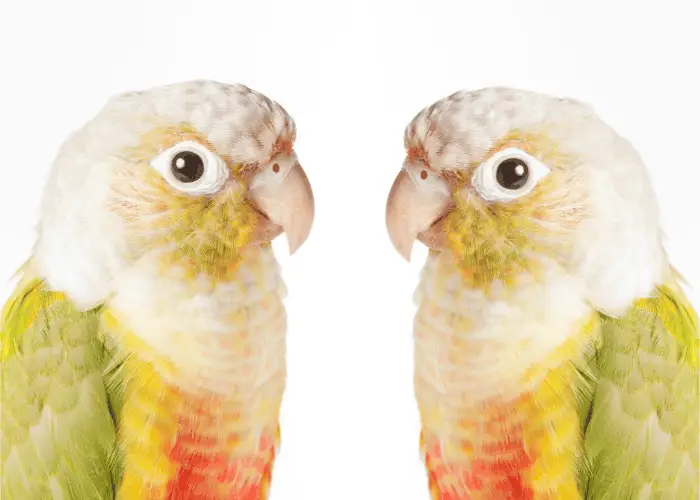
There is one surefire way to determine the sex of your Pineapple Green Cheeked Conure: putting it through a DNA test.
However, checking if the breastbone splits before reaching the tail will let you know it’s a female, as that of a male will keep going.
A DNA test can be time-consuming and an additional cost to the owner, but checking yourself is free, albeit subject to interpretation rather than being a sure thing.
Checking yourself will take some confidence, finesse, and a good amount of trust on your bird’s part.
You’ll need to hold the bird in your hand, with it lying on its back, belly up, facing you. Locate the bird’s breastbone, and carefully run your finger down the length of the breastbone, to see whether or not it parts before reaching the vent.
If it does, then it is a female. If it doesn’t, then it’s a male. Before DNA testing, this was the most popular method for sex birds. However, it is far more accurate to do this with fully matured birds rather than smaller, developing birds.
For an easier option, please wait a while; maybe it’ll lay an egg!
Conures in captivity don’t need a male around for them to lay an egg (though wild conures do). If your conure winds up laying an egg, congratulations- female Conure confirmed.
Do Pineapple Green Cheek Conures Talk?
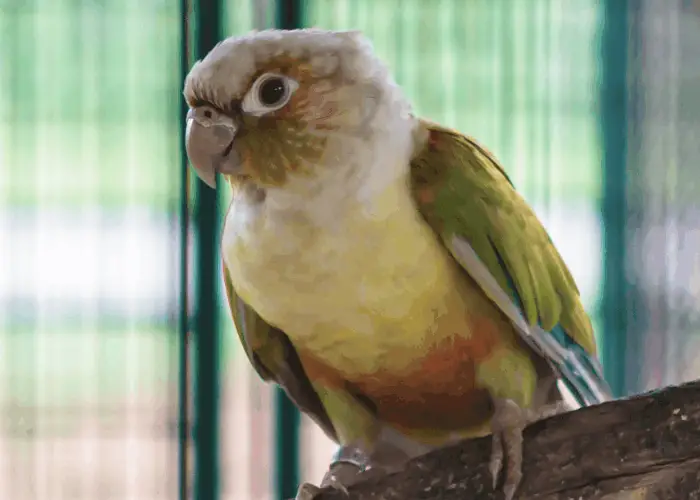
Pineapple Green Cheek Conures can talk, but not as well as some would want them to. They can be trained to say a few words but will not develop an extensive vocabulary like their larger counterparts.
Part of the reason they’re not the best talkers isn’t due to a lack of trainability. Rather, different vocal limitations prevent it from saying many human words.
When they speak words, they try to get them as close to the mark as they can, but they will often be spoken with a gravelly tone due to their vocal limitations.
The larger parrots know when to use particular words they’re trained to say. But the smaller ones, such as the Green Cheek Conure, tend only to mimic and might say words on command, but more typically, they’ll speak randomly.
They’ll also need more prompting, generally speaking, than the larger birds to get them to speak on command.
They can do a lot of mimicking other things more vocally adaptable to the Green Cheek, such as traffic going by, a crying baby, whistling, and noises of the like.
Though they can speak human words, noises (often ambient noises) are much easier for the bird to replicate and will wind up doing so the most with whichever comes easiest.
Are Pineapple Green Cheek Conures Make Good Pets?
The Pineapple Green Cheeked Conure does make for a good pet. They’ve got a good combination of a playful and affectionate personality, which results in a fun and engaging pet. They’re also a bit easier on the ears than their larger and much louder counterparts.
They’re Not Too Loud
If you’ve never owned a bird before and haven’t known anyone who does, any Conure will eventually shock your system.
However, in the world of Conures, the Green Cheek variety (the official breed of the Pineapple feather mutation) isn’t that bad, even at its worst.
It might seem loud to the novice, but to the enthusiast, they’re not that loud compared to other breeds you can wind up with as a pet.
So, the Pineapple Green Cheek will make a great family pet in every metric. Great for the family because it will be a much safer breed type to introduce to inexperienced family members carefully.
How Much Does a Pineapple Green Cheek Conure Cost?
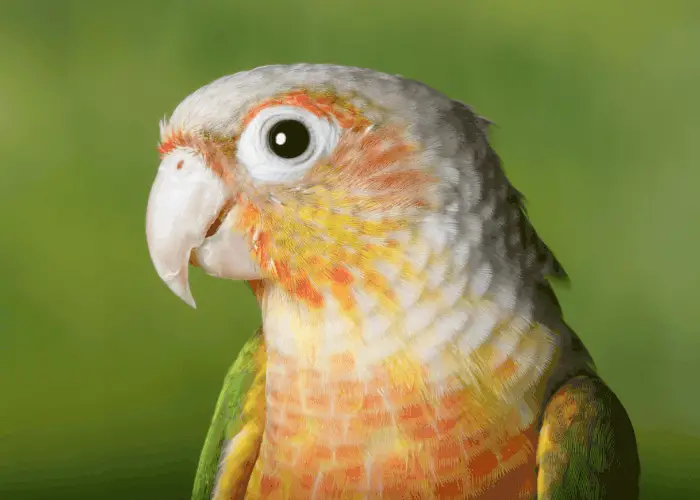
The average going cost to pick up a Pineapple Green Cheek Conure is anywhere between $400.00 to $750.00.
Turquoise Green Cheek conures also go for this price due to rarity. The prices differ depending on who’s selling it and the bird’s defining coloration quality.
Generally speaking, you’re paying extra for the color scheme of the Pineapple variety.
An ordinarily colored Green Cheek Conure will be sold from reputable breeders for around $375.00 to give you a good idea of the difference in cost due to the colors.
It is possible to find a Pineapple Green Cheeked Conure price lower if there are undesirable features in the particular coat or has strange markings that wouldn’t fly in the eyes of the breeder (again, the shameless use of puns).
Before committing to such an expense, it’s important to ensure you’re getting your bird from a reputable and responsible breeder.
The lack of doing so might result in you paying top dollar for a bird that’s lesser than its piers, no clarity of sex, or you might wind up with a Cinnamon rather than a Pineapple.
Don’t forget, when you’re looking at the price and wondering why it is so expensive, remember one thing.
The Pineapple Green Cheeked Conure lifespan is often about 30 years. That’s right, comparing a good deal of commitment to the lifespan of other, more expensive pets is great.
Where Can you Buy a Pineapple Green Cheek Conure
Here is a link I found online selling this bird: https://www.parrotstars.com
Differences Between Cinnamon and Pineapple Green Cheek Conures
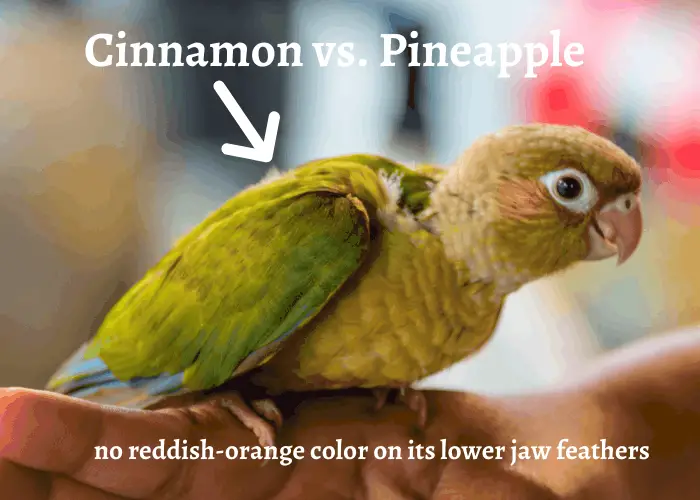
In short, the biggest difference is the location of similar colors. The Pineapple Green Cheek Conure will display a reddish-orange color on its lower jaw feathers, whereas the Cinnamon will not.
Tailfeather coloring is also a good distinguishing point. The outer edges of the Pineapple’s tail feathers are lighter in color than the rest, and the Cinnamon is not.
There are many colored Green Cheek Conures, but all are under the Green Cheek umbrella. We’re not focusing on a few of these in this article: the Suncheek Conure and a Yellow-Sided Conure, two popular variations.
Unlike other branches of the Green Cheeked Conure, two varieties often suffer from a case of mistaken identity. They are the Cinnamon and the Pineapple Green Cheeked Conure.
The Cinnamon and the Pineapple are so close in color that the Pineapple has another name, the “Cinnamon Yellow-Sided Green Cheeked Conure.” A mouthful- I know.
To be clear, aside from color mutations, these birds share the same traits, shapes, and sizes, making it all trickier to distinguish between them. But as stated above, there are differences.
Beak Under Feathers
The feathers under the lower jaw of the Pineapple are often light red or orange, and the Cinnamon’s beak under feathers, though they share a similar color, are much less defined or bold than the Pineapple. The beak under feather colors is more faded, with the Cinnamon contrasting the two.
Tail Feathers
Generally, the tail feathers of the Pineapple are richer in color, whereas the tail feathers of the Cinnamon are duller in appearance.
As aforementioned, the tail feathers of the Pineapple have a lighter colored edge around each of them, giving it a glow-like or halo appearance. The Cinnamon’s tail feathers are generally the same deep red across each feather.
Chest Coloring
This is another area of difference, the chest.
Cinnamon Green Cheek Conures have an orange-yellow tinge to their fur that is bolder in color toward the lower sections of the bird and less prevalent across its upper chest.
In some Cinnamon Conures, the color difference is low enough on the bird’s undercarriage that it has the appearance of wearing orange trunks.
The chest coloring of the Pineapple is the opposite of the Cinnamon. They tend to have the same coloring but are located higher up on the chest, at times beginning just about a half-inch under the beak of a full-grown bird.
These tell-tale signs are very general; I’d like you to know. General meaning, for example, that we know a Dalmatian is a white dog with black spots, right?
Well, that would be true. But what’s also true is that the spots will differ from one dog to the next. The same applies to birds, particularly the Pineapple and the Cinnamon Green Cheeked Conure.
Coloring might be faded on some but bolder on others, even on the same variety of Green Cheek. Knowing that is the case; it would be wise to use all three of the above indicators to judge whether or not you’re looking at a Cinnamon or a Pineapple Green Cheeked Conure.
Final Thoughts
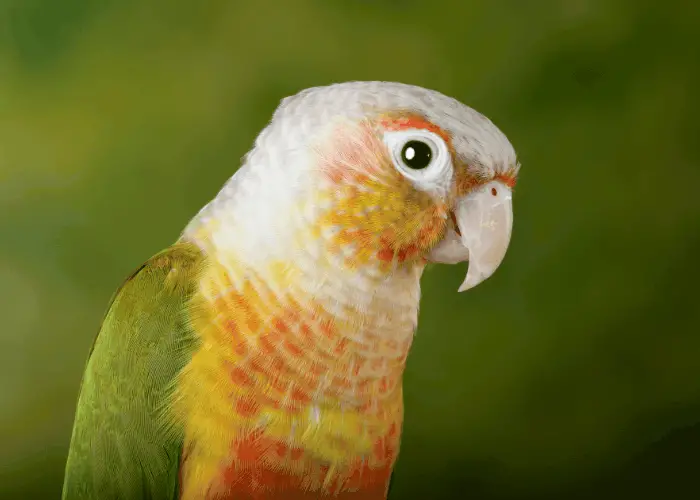
Bird ownership isn’t for everyone, but for someone interested in getting started with birds and parrots, a Pineapple Green Cheeked Conure is a visually appealing, easy-going choice.
Their even temper and affectionate personality will make the learning process of owning a bird much easier than other bird breeds- easier than other subspecies of parrots, for that matter.
Related Questions:
Are Green Cheek Conures good for Beginners?
The Green Cheek Conure variety is probably among the best selections you can make as a beginner.
Not necessarily a Pineapple variety, but the Green Cheek Conure Family is a great place to start when stepping into the “first-time bird-owning” arena.
They’re small enough to manage easily without being too intimidating to first-time owners. This is in contrast to the larger Conures, which have large, powerful beaks that can freak out people who are skittish about being bit.
Particularly for the first-time bird owner, being completely at ease with your pet is important for the owner and the pet. Birds can pick up on nervousness and can become nervous themselves when detected.
For that reason, it’s best to have a bird with which you can be comfortable and confident. The Green Cheek Conure variety is a great place to start.
REFERENCES:
1. Green-cheek conure. Queenslander Aviaries. (n.d.). Retrieved February 3, 2023, from https://www.queenslanderaviaries.com/green-cheek-conure
1. Green-cheeked parakeet. (2023, January 30). In Wikipedia. https://en.wikipedia.org/wiki/Green-cheeked_parakeet

